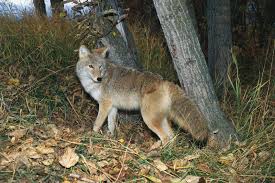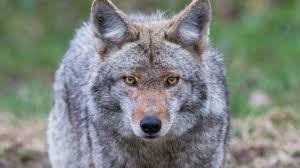Coyotes, scientifically known as Canis latrans, are fascinating creatures that roam across North America. These adaptable canids belong to the dog family and display remarkable intelligence and resourcefulness.
Coyotes are not large like wolves, but they are skilled hunters and survivors. Their fur is typically grayish-brown, helping them blend into diverse landscapes, from forests to deserts. Their keen senses, especially sharp eyesight and acute hearing, make them proficient hunters, tracking down prey such as small mammals, birds, and even insects.
These cunning animals are highly adaptable, adjusting their diets based on what’s available. From berries and fruits to small rodents, they play a crucial role in maintaining ecological balance. Coyotes are opportunistic feeders, often scavenging for food in urban areas, which has led to human-coyote encounters.
Known for their distinct vocalizations, coyotes communicate through a variety of sounds including howls, yips, and barks. These vocalizations serve various purposes, from signaling territory boundaries to coordinating within family groups.
Coyotes are social animals, living in family units led by an alpha pair. Their family structure helps in raising their pups, which are born in spring. The pups learn essential survival skills from their parents and older siblings, contributing to the resilience of the coyote population.
In recent times, human development has encroached upon coyote habitats, leading to increased interactions. While some view them as pests, others appreciate their ecological role in controlling rodent populations. Striking a balance between coexistence and managing potential conflicts is essential to ensure the well-being of both humans and coyotes.
Conservation efforts often focus on educating the public about the importance of coyotes in ecosystems. By understanding and respecting these intelligent canids, humans can contribute to maintaining the delicate balance of nature.
However, Coyotes, scientifically referred to as Canis latrans, are captivating creatures with a wide range of adaptations. Their ability to thrive in diverse environments, coupled with their social structure and unique vocalizations, makes them a vital component of North America’s ecosystems. As we navigate shared spaces with coyotes, a harmonious coexistence is not only possible but crucial for preserving the intricate web of life on our continent.
Read Also: Proper Management Measures for Poultry Birds During Summer (Heat)
Animals Affected by Coyotes

Coyotes, as apex predators, can have an impact on various animal species within their ecosystems. While their presence is a natural part of the food web, it can influence the abundance and behavior of certain animals.
1. Small Mammals: Coyotes primarily prey on small mammals such as rabbits, rodents, and squirrels. The presence of coyotes can affect the population dynamics of these smaller animals, creating a balance in the ecosystem.
2. Birds: Coyotes may opportunistically prey on birds, especially ground-nesting species. This can influence the distribution and behavior of certain bird populations, leading them to choose nesting sites with greater safety from ground predators.
3. Insects and Invertebrates: While not a primary food source, coyotes may consume insects and invertebrates as part of their varied diet. This can indirectly impact the populations of these smaller creatures.
4. Deer: Although coyotes are not large enough to regularly take down adult deer, they can have an impact on deer populations. Coyotes may prey on fawns, particularly during the vulnerable period shortly after birth. This predation can influence deer population dynamics.
5. Domestic Pets: In urban and suburban areas, coyotes may pose a threat to domestic pets such as cats and small dogs. It is essential for pet owners to be aware of the potential presence of coyotes and take precautions to protect their animals.
6. Livestock: In rural areas, coyotes can pose a risk to livestock, especially young or vulnerable animals. Farmers and ranchers often implement measures to protect their livestock from coyote predation.
It’s important to note that while coyotes do influence the populations of certain species, their presence also plays a crucial role in maintaining ecosystem balance. The control of smaller mammal populations by coyotes, for example, can prevent overgrazing and help maintain healthy plant communities. Conservation efforts often aim to strike a balance that allows for the coexistence of coyotes and other wildlife while minimizing negative impacts on domestic animals.
Damages Caused by Coyotes

Coyotes, while playing a vital role in ecosystems, can sometimes be associated with certain challenges and damages, particularly in areas where human activities intersect with their habitats. Some of the concerns include:
1. Livestock Predation: Coyotes may pose a threat to livestock, especially young or vulnerable animals such as lambs or calves. This can result in economic losses for farmers and ranchers. Implementing effective predator management strategies is crucial in minimizing these damages.
2. Pet Predation: In urban and suburban areas, coyotes may prey on domestic pets, including cats and small dogs. Pet owners need to be vigilant and take precautions to reduce the risk of interactions between coyotes and pets.
3. Crop Damage: While not primarily herbivores, coyotes might cause some damage to crops, particularly in agricultural areas. Their presence may disturb or trample crops, impacting yields to some extent.
4. Concerns for Human Safety: Although rare, there have been occasional reports of coyotes displaying aggressive behavior towards humans, particularly if they feel threatened or if they have become habituated to human presence. It’s essential for people to exercise caution and avoid feeding or approaching wild coyotes.
5. Impact on Native Wildlife: In some cases, the presence of coyotes may influence the behavior and population dynamics of certain native wildlife species. This can lead to shifts in ecological balance, affecting other components of the ecosystem.
It’s crucial to approach the issue of damages caused by coyotes with a balanced perspective. While addressing concerns related to livestock and pets, it’s important to recognize the ecological role coyotes play in controlling smaller mammal populations and contributing to overall ecosystem health.
Management strategies often involve a combination of education, coexistence practices, and, in specific cases, targeted control measures to address specific challenges without jeopardizing the species’ overall conservation status.
Read Also: Steps to Combat Heat Stress in Poultry Birds
Control and Preventive Measures

To manage and prevent conflicts with coyotes, various control and preventive measures can be implemented. These strategies aim to minimize potential damages while promoting coexistence between humans and coyotes:
1. Education and Public Awareness: Informing the public about coyote behavior, ecology, and the importance of coexistence is crucial. Outreach programs can help residents understand how to safely interact with coyotes and take preventive measures.
2. Secure Livestock Enclosures: Implementing sturdy fencing and secure enclosures for livestock can help prevent coyote predation. This is particularly important for vulnerable animals such as lambs or calves.
3. Pet Safety Measures: Pet owners should take precautions to protect their animals. This may include keeping pets indoors during peak coyote activity times, using leash restraints, and avoiding leaving pet food outdoors.
4. Avoid Feeding Coyotes: Feeding wild coyotes can lead to habituation, where they lose their natural fear of humans. This can increase the likelihood of negative interactions. It is essential for people to refrain from intentionally or unintentionally feeding coyotes.
5. Remove Attractants: Secure garbage bins, eliminate potential food sources, and manage compost piles to avoid attracting coyotes to residential areas. By reducing attractants, the likelihood of human-coyote conflicts can be minimized.
6. Scare Tactics: Employing scare tactics such as loud noises, bright lights, or motion-activated devices can help deter coyotes from entering specific areas. These non-lethal methods aim to create an aversion to human-occupied spaces.
7. Professional Trapping and Removal: In situations where coyotes pose a significant threat to human safety or cause severe damage, professional trapping and removal may be considered. This should be done by trained wildlife management experts following ethical and legal guidelines.
8. Collaboration with Authorities: Local authorities, wildlife agencies, and animal control services play a crucial role in managing coyote-human conflicts. Collaborative efforts can include monitoring coyote populations, responding to public concerns, and implementing appropriate control measures when necessary.
9. Research and Monitoring: Continuous research on coyote behavior and population dynamics helps improve understanding and informs effective management strategies. Monitoring coyote activity in urban and rural environments allows for timely interventions when needed.
Implementing a combination of these measures helps strike a balance between addressing specific concerns related to coyotes and ensuring the preservation of their ecological role. It’s important to approach coyote management with a comprehensive and science-based perspective, taking into consideration both human safety and the conservation of these important wildlife species.
Frequently Asked Questions (FAQs) About Coyotes (Canis latrans)
Q1: Are coyotes dangerous to humans?
A1: While coyotes are generally shy and avoid human interaction, there have been rare cases of aggression, especially when they feel threatened. It’s essential to exercise caution and avoid feeding or approaching wild coyotes.
Q2: What should I do if I encounter a coyote?
A2: If you encounter a coyote, stay calm, make noise, and appear larger by raising your arms. Never run away, as this may trigger a chase instinct. Back away slowly and give the coyote space to retreat.
Q3: Do coyotes pose a threat to pets?
A3: Yes, coyotes may prey on small pets, especially in urban and suburban areas. Pet owners should take precautions, such as keeping pets indoors during peak coyote activity times and securing outdoor areas.
Q4: Can I feed coyotes?
A4: No, feeding coyotes can lead to habituation, where they lose their fear of humans. This increases the risk of conflicts and negative interactions. It’s crucial to avoid intentional or unintentional feeding.
Q5: What is the role of coyotes in ecosystems?
A5: Coyotes play a vital role in controlling populations of small mammals, helping maintain ecological balance. They contribute to healthy ecosystems by regulating prey species and preventing overgrazing.
Q6: How can I protect my livestock from coyote predation?
A6: Implementing secure fencing and enclosures for livestock is crucial. Additionally, using guard animals, such as llamas or dogs, can help deter coyotes from approaching livestock.
Q7: Are there specific times when coyotes are more active?
A7: Coyotes are crepuscular, meaning they are most active during dawn and dusk. Being aware of these peak activity times can help reduce the likelihood of encounters.
Q8: Do coyotes live in groups?
A8: Yes, coyotes often live in family groups led by an alpha pair. These family units contribute to the raising and teaching of their pups.
Q9: What can communities do to manage coyote-related issues?
A9: Communities can focus on education, implementing secure waste management practices, and collaborating with wildlife agencies to address concerns. Public awareness helps foster coexistence.
Q10: Are there humane methods for managing coyote populations?
A10: Yes, humane methods include education, scare tactics, and non-lethal deterrents. Professional trapping and removal should only be considered in situations where there is a significant threat to human safety or property.
Read Also: E-Trade Business Opportunities for Expansion and Types of E-Trade

